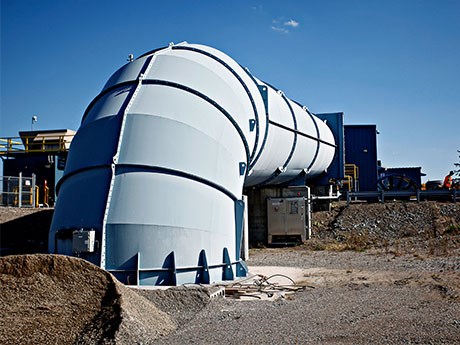Ventilation on demand, blasting and surveying innovations
Overseeing mine planning, execution and scheduling at a brand new mine is a once in a lifetime experience.
For Erick Jarvi, it’s a dream come true. A Laurentian University mining engineering grad, Jarvi joined Inco in 1997 as a production miner at the company’s Levack Mine.
He spent four years as an hourly employee and six years as a production supervisor at Coleman before transferring into engineering at Creighton Mine.
Starting at the bottom and working your way up isn’t unusual given the cyclical nature of the mining industry and the difficulty of landing an engineering job in a down market. In Jarvi’s case, the wealth of experience he gained at the face paid off in January when he was appointed chief mine engineer at Totten.
Hailed as “a mine of the future,” Totten offers Vale an opportunity to introduce cutting-edge technology for ground control, ventilation and surveying, all of which are overseen by the chief mine engineer.
Blasthole stoping
The vertically dipping orebody lends itself to blasthole stoping, a mining method which is commonly used across the Sudbury Basin, said Jarvi.
“We’re looking at lift heights of 120 to 140 feet and we incorporate a four-foot raisebore slot raise coupled with 4.5- inch in-the-hole production drilling, so our average stopes range from 15,000 to 30,000 tonnes.
The Totten production fleet will include Redbore 40 raise drills and two fully automatic Atlas Copco Simba in-the-hole drills. The load-haul-dump machines are six-yard Elphinstone Caterpillar units. Resin rebar will be used for primary ground support along with some dynamic support where warranted.
“We have a couple areas where we intersect a trap dyke, so we use the trap dyke protocol there,” said Jarvi. “We also have a very advanced ESG Solutions microseismic system that provides realtime source location.”
The microseismic system is monitored from Totten’s control room and from several computers underground in active working areas, allowing control room staff and production supervisors to visualize seismic activity in real time.
“If there’s an event, we can identify the magnitude and location, and make sure workers are out of harm’s way,” said Jarvi. A ventilation-on-demand system from Simsmart Technologies controls louvers and modulates fans with variable speed drives to direct air based on the detection of RFID tags installed on mobile equipment and in miners cap lamps.
“The purpose isn’t necessarily to save power, but to maximize efficiency,” said Jarvi. “It ensures that ventilation is being used efficiently across the mine and drastically improves blast clearing time by shutting off areas where air is flowing for nothing and focusing on where the ventilation is really needed.”
The system is able to distinguish between an LHD and a personnel carrier and adjust the volume of air accordingly.
Totten is also pioneering new technology for surveying, having opted for the Miner Operated Survey System (MOSS).
“We’re the first Vale mine to incorporate the wall bar system and the MOSS system,” said Jarvi. “It reduces the amount of survey attention that the development needs, but it’s also a big improvement in safety because we no longer have to use smoke marks on the back. There’s a lot less of a requirement to work at the back. You can almost do all the surveying without even having to use a manlift and there’s no more drilling overhead which used to result in injuries with people getting dust in their eyes. It’s a much more efficient system because the surveyors don’t have to go down as often.”
Totten is also planning to do mass blasting.
“Mass blasting is gaining momentum with Vale,” said Jarvi. “It allows us to blast out an entire stope in two or three blasts maintaining a full brow and maximizing our mucking efficiency. A lot of the mines are using six-inch or 6.5-inch drilling. We’re going to use 4.5-inch drilling, but it’s the electronic detonators that give us a lot more flexibility and a lot more delay time to play with. It’s a lot more efficient because it reduces the amount of time that a blaster has to go in and plug holes and measure holes.”
To begin with, there will be two mining fronts – one on the 3150 level and another on the 3800 level. A third mining front will be established on the 4170 level in 2015.
“We have a solid mine plan, a skilled technical team backed by a quality ground control program and a state-of-the-art microseismic system that should ensure a safe operation,” said Jarvi.


